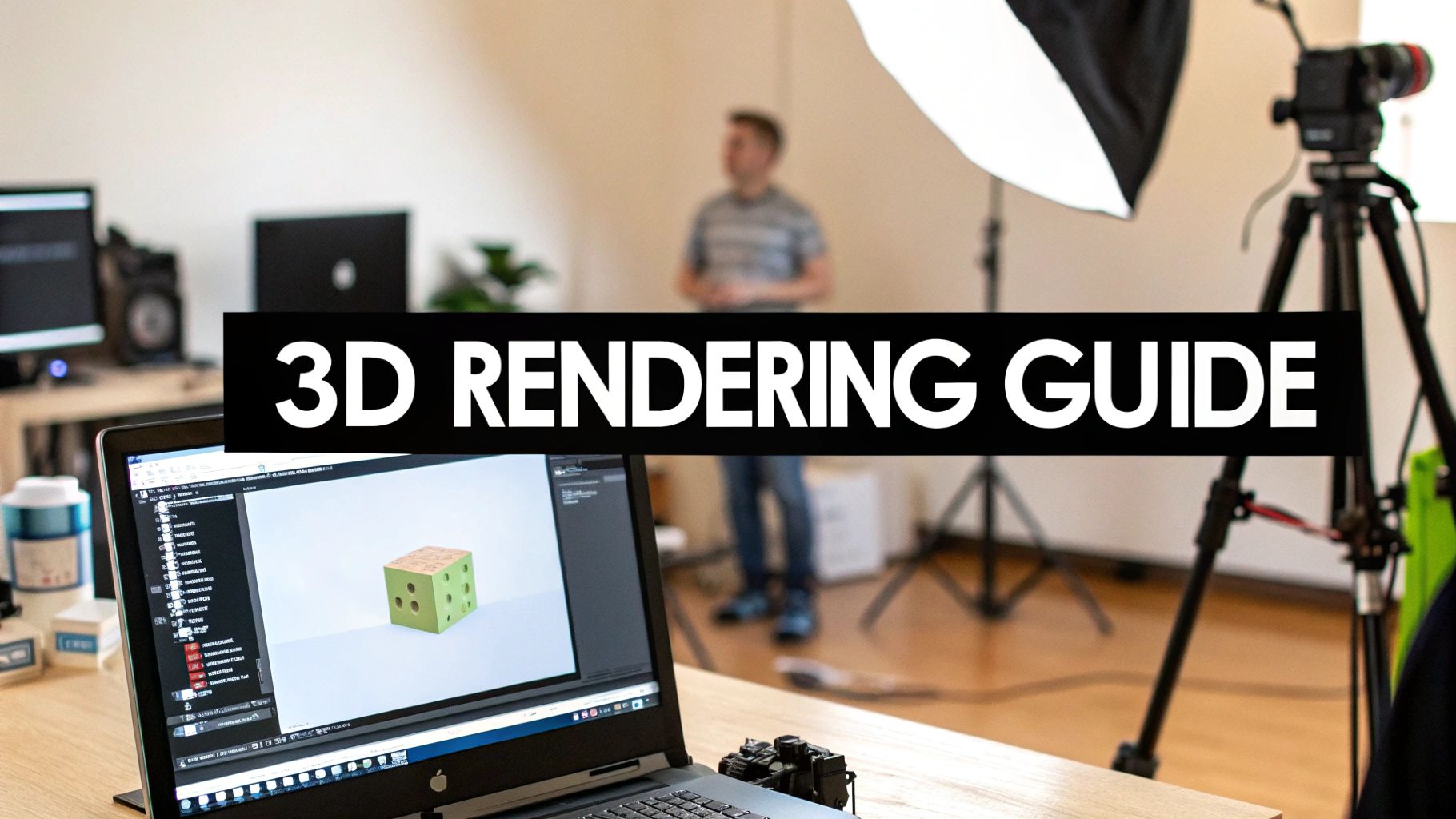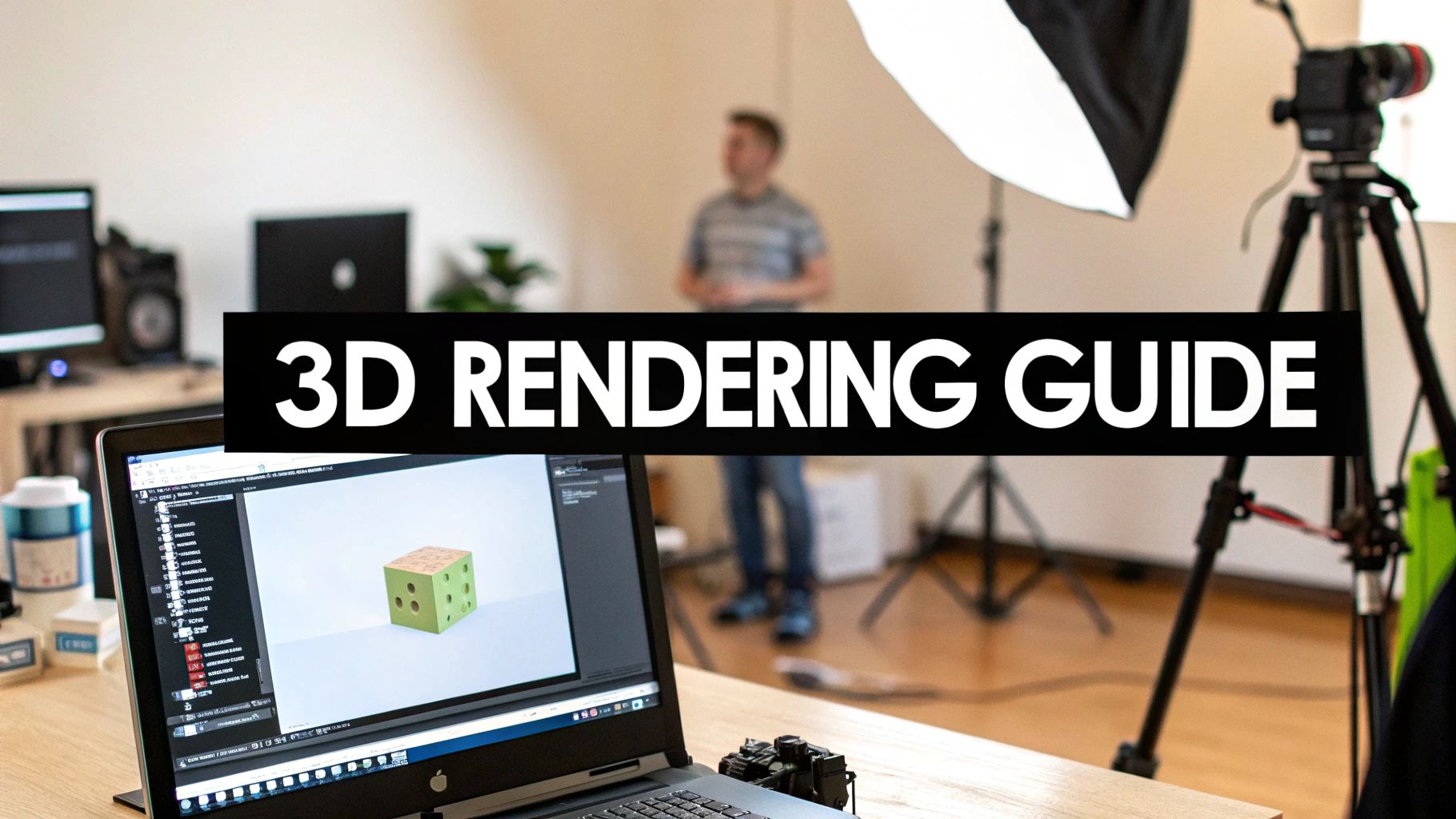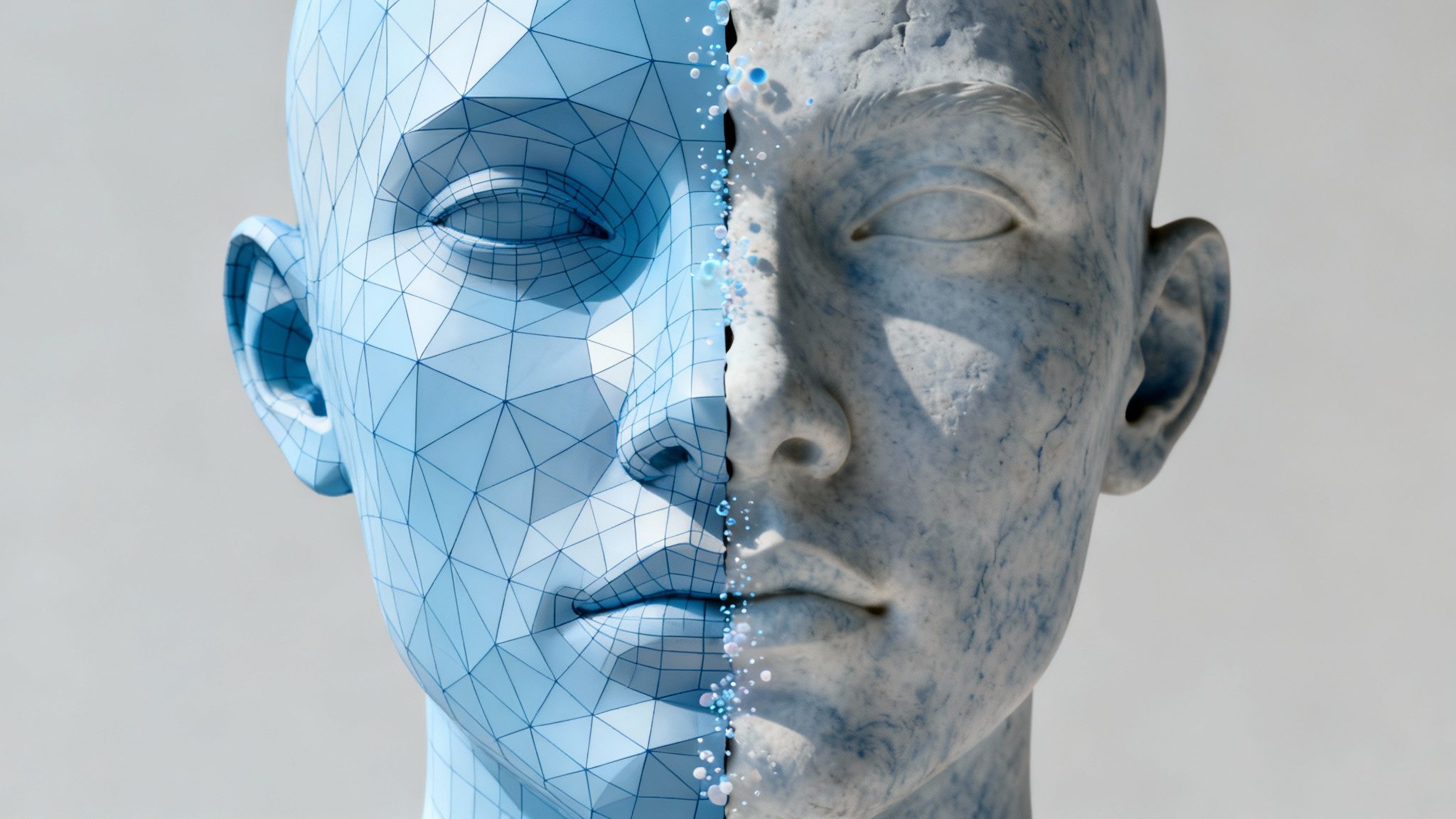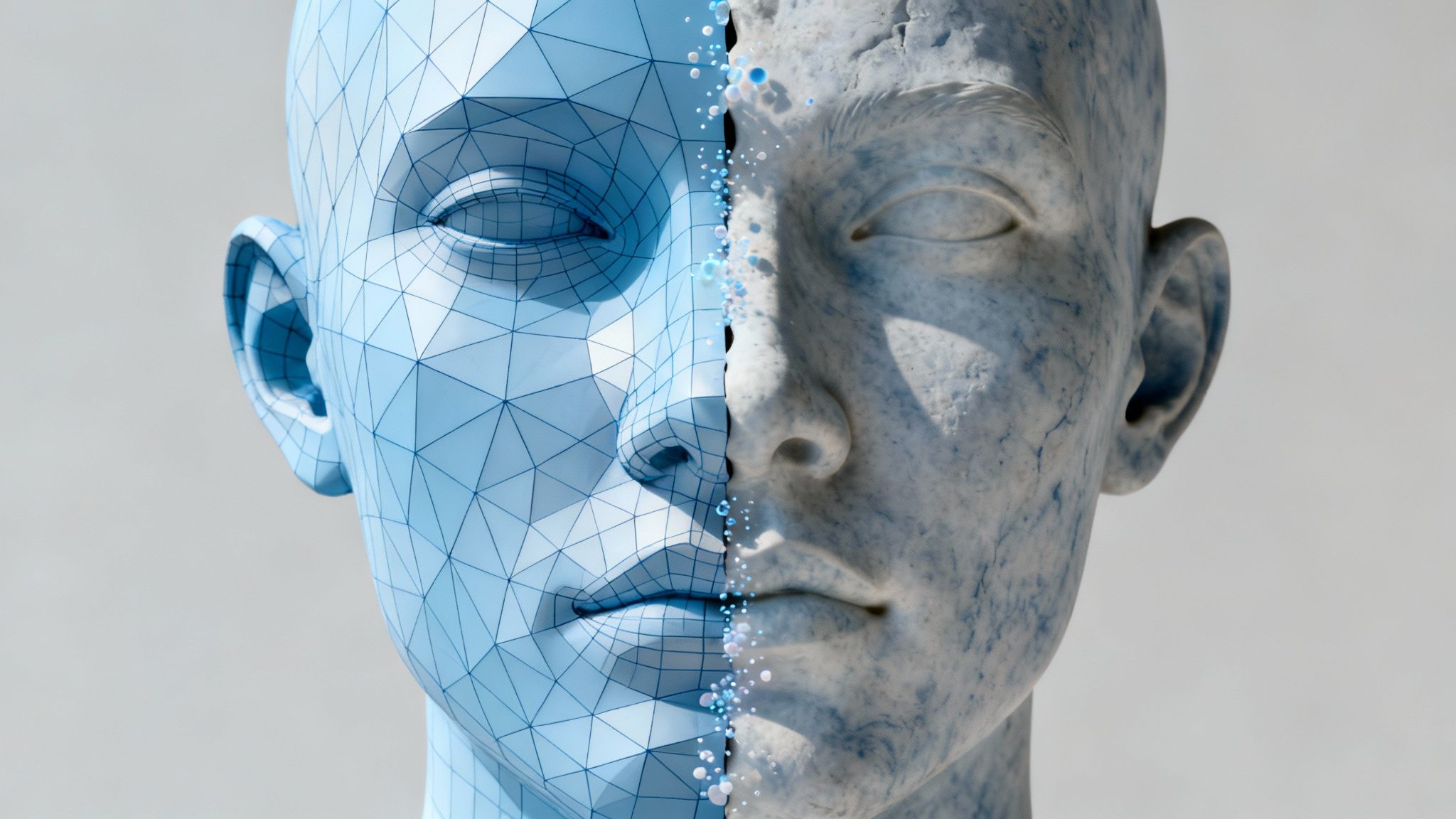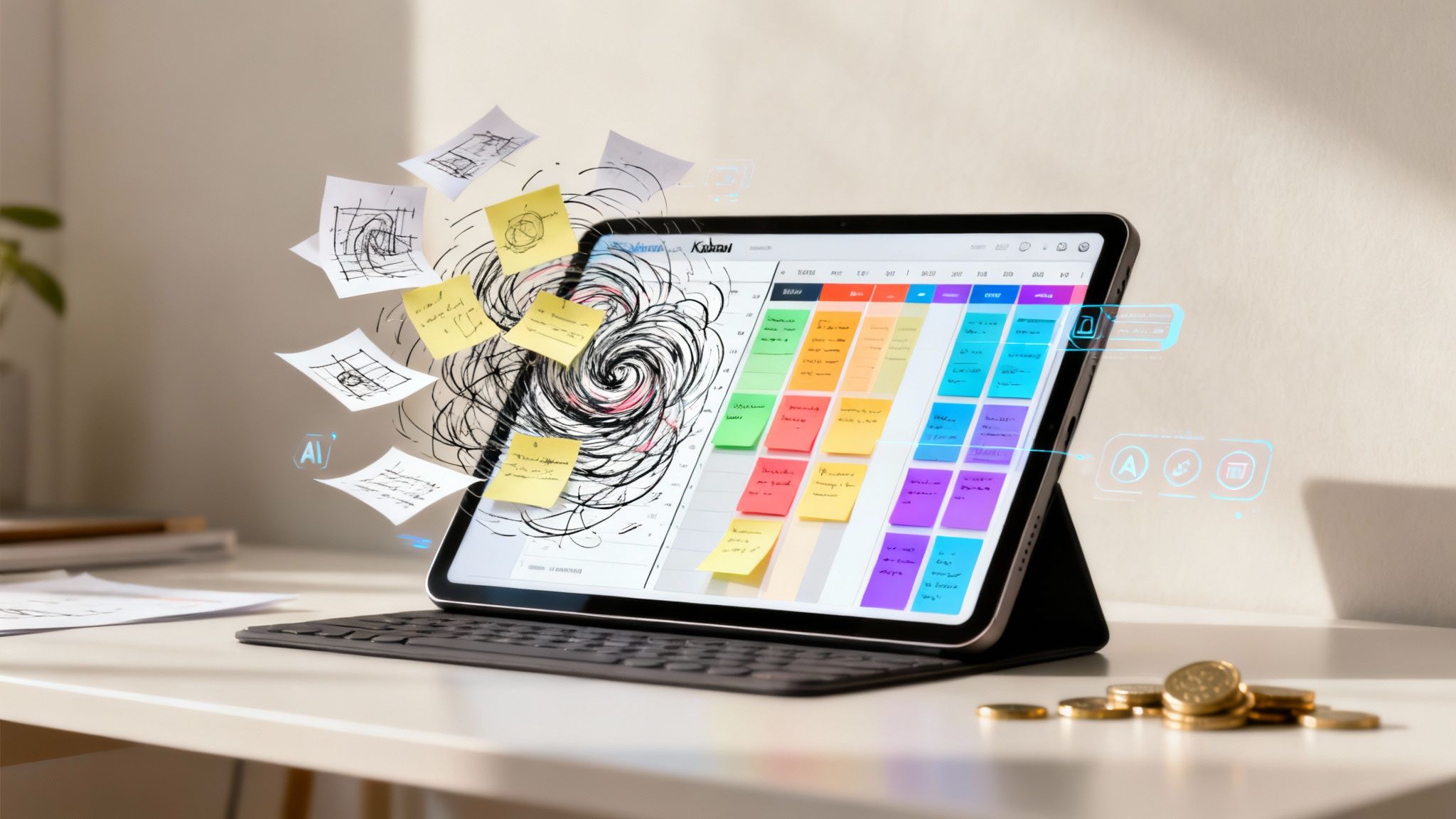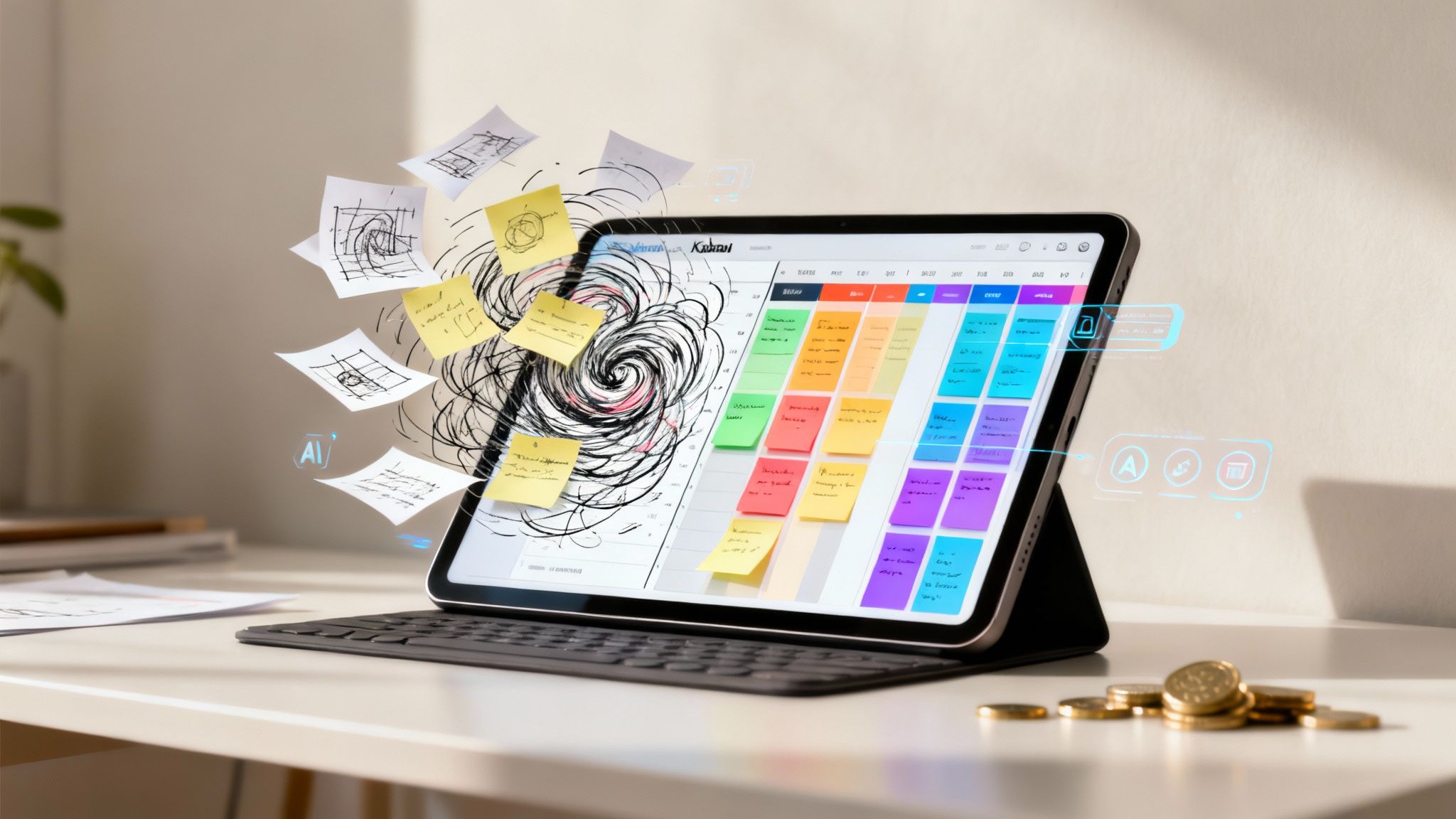What exactly is 3D product rendering?
At its core, it's the process of creating a perfectly photorealistic image from a digital 3D model. Think of it as a virtual photoshoot, but with one significant advantage: you have complete creative control over every single detail, all from a computer.
A Virtual Photoshoot Without the Logistical Hurdles
Imagine you need stunning new shots for your latest product launch. The traditional route can be a logistical challenge—hiring photographers, booking a studio, shipping fragile prototypes, and hoping the weather cooperates.
3D product rendering eliminates these complexities. It’s a structured creative and technical workflow that transforms a digital blueprint into a breathtakingly lifelike visual. The final image is often completely indistinguishable from a real photograph.
With this approach, you can place your product into any environment imaginable, adjust the lighting with a single click, and cycle through dozens of colors and materials in minutes. It offers a level of creative freedom and agility that traditional photography simply cannot match.
From Digital Blueprint to Marketing Asset
The entire process begins with a 3D model, which is essentially the digital DNA of your product. From there, artists apply textures, arrange lighting, and set up virtual cameras to frame the perfect shot.
The final step happens during the "render," where the software processes all that data to produce the finished image.
This means you can:
- Visualize products in perfect detail long before manufacturing begins.
- Generate an entire product catalog without a single physical sample on hand.
- Evaluate different designs and color schemes without committing to expensive production runs.
- Place your product in a Tuscan villa or a minimalist downtown loft—settings that would be prohibitively expensive or impossible to shoot in real life.
In short, 3D rendering closes the gap between an idea and a powerful marketing asset ready for your next campaign. It’s become a critical tool for any modern brand that needs to operate efficiently and create high-impact visuals.
For marketing and e-commerce professionals, this is more than just an interesting piece of technology; it’s a significant strategic advantage. It allows marketing development to run in parallel with product development, shortening your time-to-market. By removing the need for physical prototypes for photos, you can launch faster and react to market trends with incredible speed.
Why Top Brands Are Integrating 3D Product Rendering
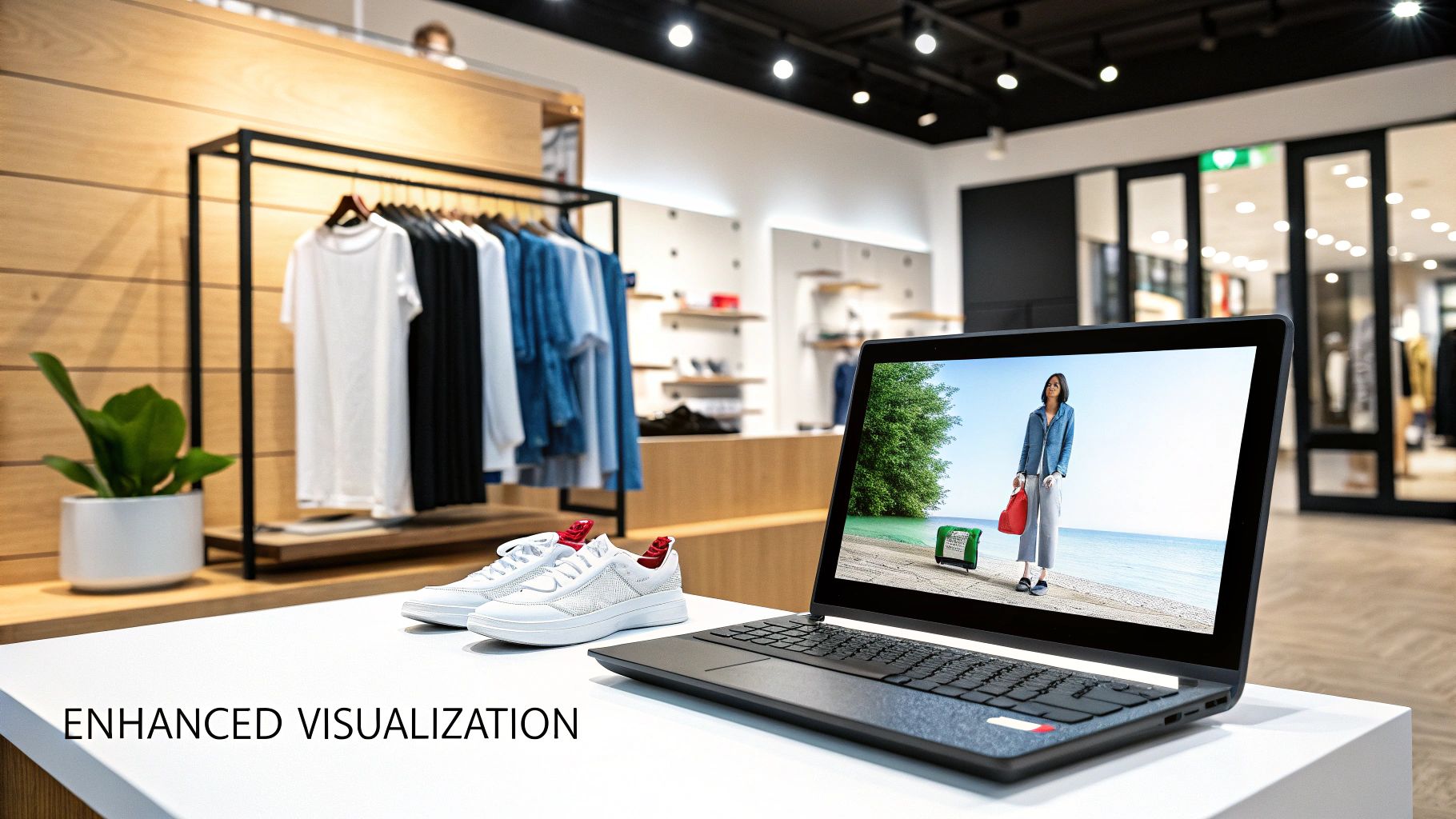
The "what" is clear—but why are the world's leading companies making 3D product rendering a standard part of their visual strategy? The answer isn’t just about creating attractive pictures. It’s a strategic shift that delivers tangible returns in speed, cost savings, and creative capability.
For decades, getting a product to market was a slow, linear process. First, you design it. Then, you invest significant resources into physical prototypes. Finally, you ship those prototypes for a complex and expensive photoshoot. This rigid, sequential process meant marketing was always playing catch-up, their work dependent on the existence of a physical product.
3D rendering transforms that old model. It lets product development and marketing run on parallel tracks, which completely changes the workflow and accelerates the entire go-to-market timeline.
Shorten Time to Market
Imagine your marketing team creating compelling campaign visuals, lifestyle shots, and e-commerce listings while the final product is still just a CAD file on a designer's computer. With 3D product rendering, that’s not a future concept—it’s the new standard. There's no more waiting for a prototype to arrive before you can start building awareness.
This parallel workflow is a significant competitive advantage. You can launch pre-order campaigns, gauge market interest, and have a full launch plan ready to go months ahead of the competition.
Expand Your Creative Freedom
Let's be clear: traditional photography is bound by the real world, limited by physics and, more importantly, by budget. Renting the perfect location, finding the right props, and coordinating all the logistics can quickly become a major undertaking. 3D product rendering frees your brand from all of that.
You can place your product anywhere you can imagine—a sun-drenched beach in Bali, a sleek apartment in Tokyo, a futuristic cityscape—all without leaving the office. This unlocks a universe of creative possibilities for telling your brand’s story.
- Endless Variations: Want to show a new armchair in 200 different fabric options? It's entirely possible. You can do it without ever touching a single swatch of real fabric.
- Perfect Context: Display your new line of outdoor furniture in a perfectly manicured garden at golden hour or showcase high-end electronics in a minimalist, modern home.
- Flawless Consistency: Keep every single image perfectly on-brand. The lighting, angles, and aesthetic will be identical across every shot, giving you a polished and professional look everywhere.
When you remove physical constraints, your visuals can finally match your creative vision, not just what’s possible to set up in a photo studio. That consistency builds a much stronger and more memorable brand identity.
Achieve Significant Cost Reductions
Creating a high-quality 3D model is an upfront investment, but the long-term savings are where the process truly shines. Consider the recurring costs of traditional photography for a whole product catalog: photographer fees, studio rentals, prototype shipping, set design, prop rentals… the expenses add up quickly.
This is exactly why the global 3D product rendering market is expanding. Valued at $3.85 billion in 2023, it’s projected to reach $23.78 billion by 2034. Why? Because it makes the whole process more efficient. As one industry report notes, being able to visualize products before they’re made reduces material waste and gets them to market faster. You can learn more about the industry's rapid expansion and its impact on the market right here.
With 3D, you create a digital asset once. That model can then be reused, adjusted, and repurposed indefinitely—for new campaigns, different backgrounds, or even animations—at a fraction of what a reshoot would cost. For ambitious brands, this isn't just a smarter way to work. It’s a sustainable way to scale your visual content and stay ahead.
Comparing Traditional Photography and 3D Product Rendering
To fully appreciate the difference, it helps to put the two head-to-head. The traditional method has served its purpose, but the advantages of a digital-first approach are clear.
The takeaway is simple: while photography captures reality, 3D rendering lets you create the perfect reality for your brand, over and over again.
How a Digital Product Comes to Life
So, you see the potential of 3D product rendering. But how does a simple idea transform into a high-quality, photorealistic image? It’s not a one-click process. It's a structured workflow, a digital assembly line where artists build, polish, and capture a product inside a virtual world.
Let's look at the four main stages. Understanding these core steps helps you appreciate the craft behind every great render and makes collaborating with creative teams much smoother.
Stage 1: Digital Sculpting
Everything starts with the foundation: the 3D model. This is the digital blueprint of your product, meticulously built in specialized software. Think of it as a sculptor carving a block of digital clay into a precise, detailed object.
Every curve, edge, and component is constructed to scale, making sure the final asset is a perfect replica of the real thing. This model can be created from scratch using design documents and photos, or it can be built from existing computer-aided design (CAD) files straight from manufacturing. A clean, accurate model is non-negotiable—any flaws here will be noticeable in the final image.
Stage 2: Applying Surfaces
A plain 3D model is like an unpainted car—it has the shape, but none of the character. The second stage, texturing and material application, is where the product gets its personality. Here, artists assign digital materials to every surface to mimic its real-world look and feel.
This is much more than just picking a color. It’s about defining how light interacts with the surface:
- Texture: Is it rough like raw wood, slick like polished chrome, or soft like suede?
- Reflectivity: Does it have a mirror-like shine or a flat, matte finish?
- Transparency: Is it see-through like glass or solid like ceramic?
By layering these properties, artists can recreate anything from the subtle grain in a leather wallet to the brushed finish on a kitchen appliance.
This is the moment a simple model starts looking like a real, tangible product. It’s the difference between a dull gray shape and an object so rich in detail you can almost feel it through the screen.
The infographic below gives a high-level look at how the intended outcome guides the entire rendering approach.
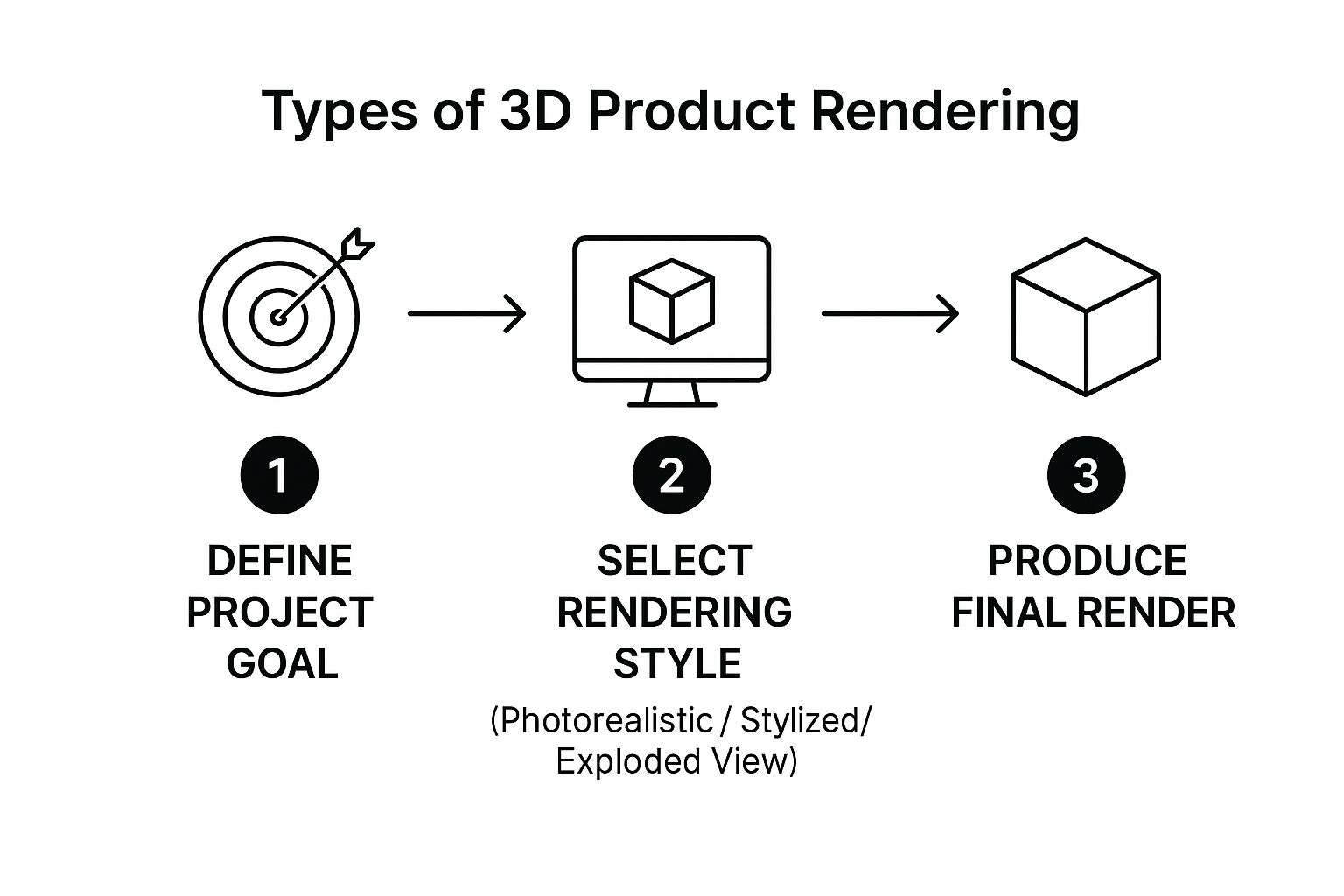
As you can see, defining the goal—whether it's a photorealistic shot or something more stylized—is the first critical step before the technical work begins.
Stage 3: Setting the Scene
With a fully textured model ready, it’s time to act as a virtual photographer. The third stage is all about lighting and composition. The product is placed into a digital scene and lit to perfection. Just like in a real photo studio, lighting is everything. It sets the mood, highlights key features, and casts the shadows that give an object a sense of weight and depth.
Artists use a toolkit of virtual lights—softboxes, spotlights, or even natural sunlight—to craft the perfect atmosphere. They also set the camera angle, focal length, and depth of field to compose the shot, directing the viewer’s eye exactly where it needs to go. This is where artistic vision truly shapes the product's story.
Stage 4: Creating the Final Image
Finally, we have the last step. Rendering and post-processing is the technical stage where the computer takes all the data—the model's shape, its materials, the lighting, the camera settings—and processes it to generate the final 2D image.
This can be computationally intensive, sometimes taking minutes or even hours for a single image, depending on the complexity and quality needed. Once the raw render is complete, artists often move into post-processing. Here, they make fine-tune adjustments to color balance, contrast, and sharpness, just as a photographer edits a photo. This final polish ensures the image is vibrant, balanced, and ready for your marketing campaign.
For a deeper dive into this final stage for both static images and video, check out our detailed guide on 3D product rendering and animation. With that, the journey from a simple file to a compelling visual is complete.
How Rendering Is Used in Business Applications
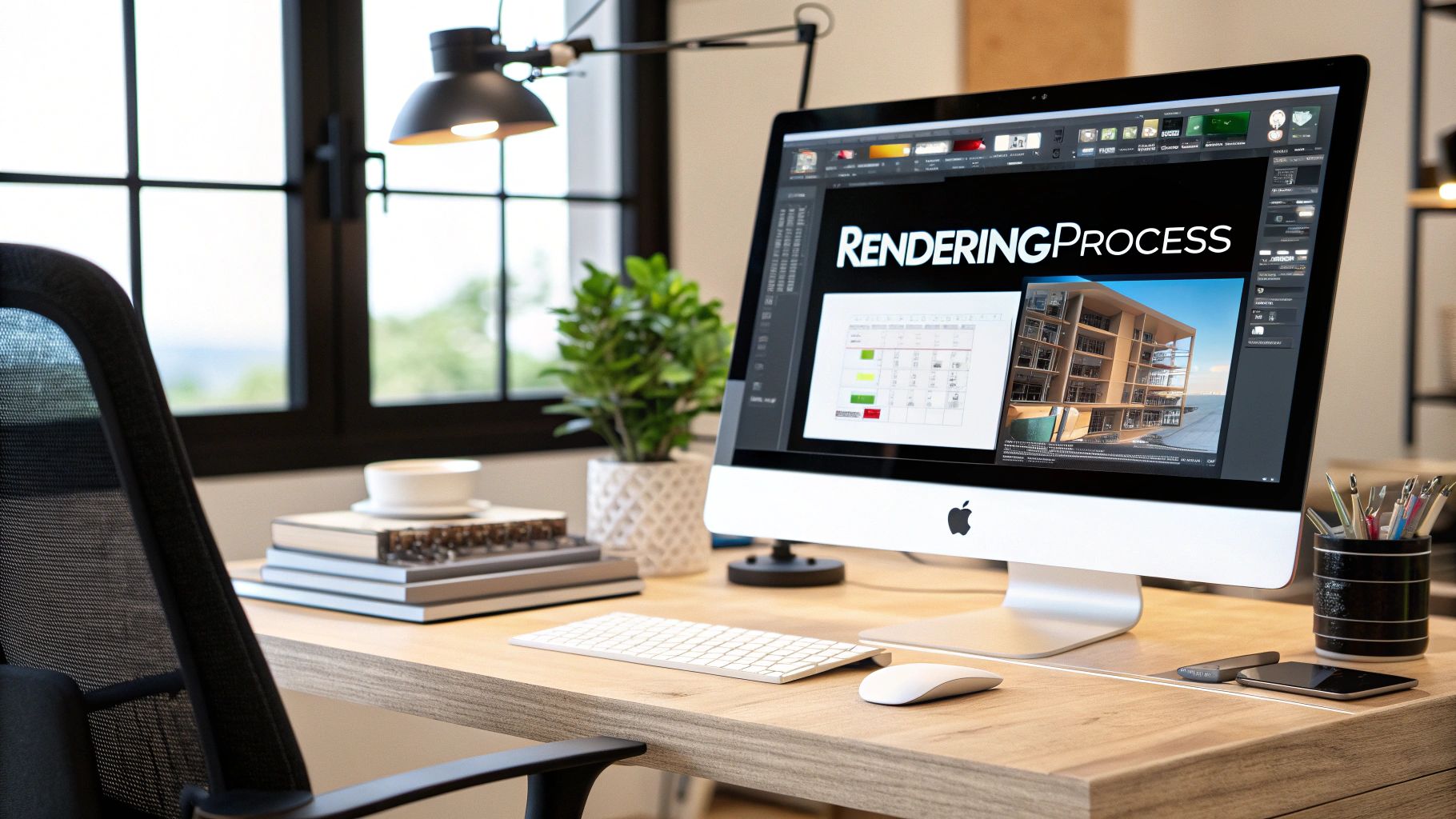
Understanding the workflow is one thing, but the real value becomes clear when you see 3D product rendering in action. This isn't just about creating clean product shots on a white background. It's the engine behind some of the most engaging visual content available today.
Think of rendering as the bridge between a digital file and a genuine customer connection. It lets brands show their products in ways that were once impossible, moving far beyond static photos to drive real engagement and sales.
Powering Interactive Product Configurators
One of the most effective applications of 3D product rendering is the interactive product configurator. Instead of endlessly scrolling through photos, customers get to be the designers.
Imagine a shopper on a car website, swapping paint colors, changing the interior trim, and trying on different wheels in real-time. Or someone shopping for a sofa, instantly cycling through hundreds of fabrics and colors to see what fits their home. That is rendering at work.
This level of customization turns passive browsing into an active, creative experience. When customers can build their own perfect product, they feel a sense of ownership before they even click "add to cart." It’s a powerful tool for building buying confidence.
Creating Captivating Lifestyle Scenes
Traditional lifestyle photoshoots come with major logistical hurdles—location scouting, set dressing, prop rentals, and significant costs. With 3D product rendering, all of that is simplified. Brands can place their products in any environment they can imagine.
A kitchenware company can instantly drop its new pans into a rustic farmhouse kitchen, a sleek modern loft, or a sun-drenched Italian villa. This isn’t just about making an attractive picture; it’s about storytelling. It helps customers visualize the product in their own life.
These "in-situ" shots are what create desire. They turn a simple object into an aspirational piece of a lifestyle, making it infinitely more appealing.
By placing products in perfect, curated settings, brands can evoke the exact emotion they want to associate with their products, whether it's comfort, luxury, or adventure.
From Assembly Guides to Augmented Reality
The power of a 3D model doesn't stop with static images. It's a reusable asset that can be adapted into all kinds of dynamic content.
- Animated Assembly Instructions: Instead of confusing paper manuals, companies can create simple, step-by-step 3D animations that show exactly how a product fits together. This can reduce customer frustration and support calls.
- Exploded Views: To showcase excellent engineering, a brand can create an animation that deconstructs a product, piece by piece. It's a visually compelling way to highlight build quality and internal components.
- Augmented Reality (AR): This is where technology becomes truly immersive. AR lets a customer use their phone to place a true-to-scale 3D model of a product right in their own room. Want to see if that armchair really fits in your living room? Now you can.
These uses show that a single 3D model has almost limitless potential. It’s no surprise the 3D product rendering market is growing. Starting from a $6.4 billion valuation in 2025, it’s projected to soar past $40.97 billion by 2035, all thanks to trends like real-time rendering and AR. You can discover more insights about this market expansion. This is no longer a niche tool; it's becoming central to how modern companies create and market their products.
How AI Is Shaping the Future of Rendering
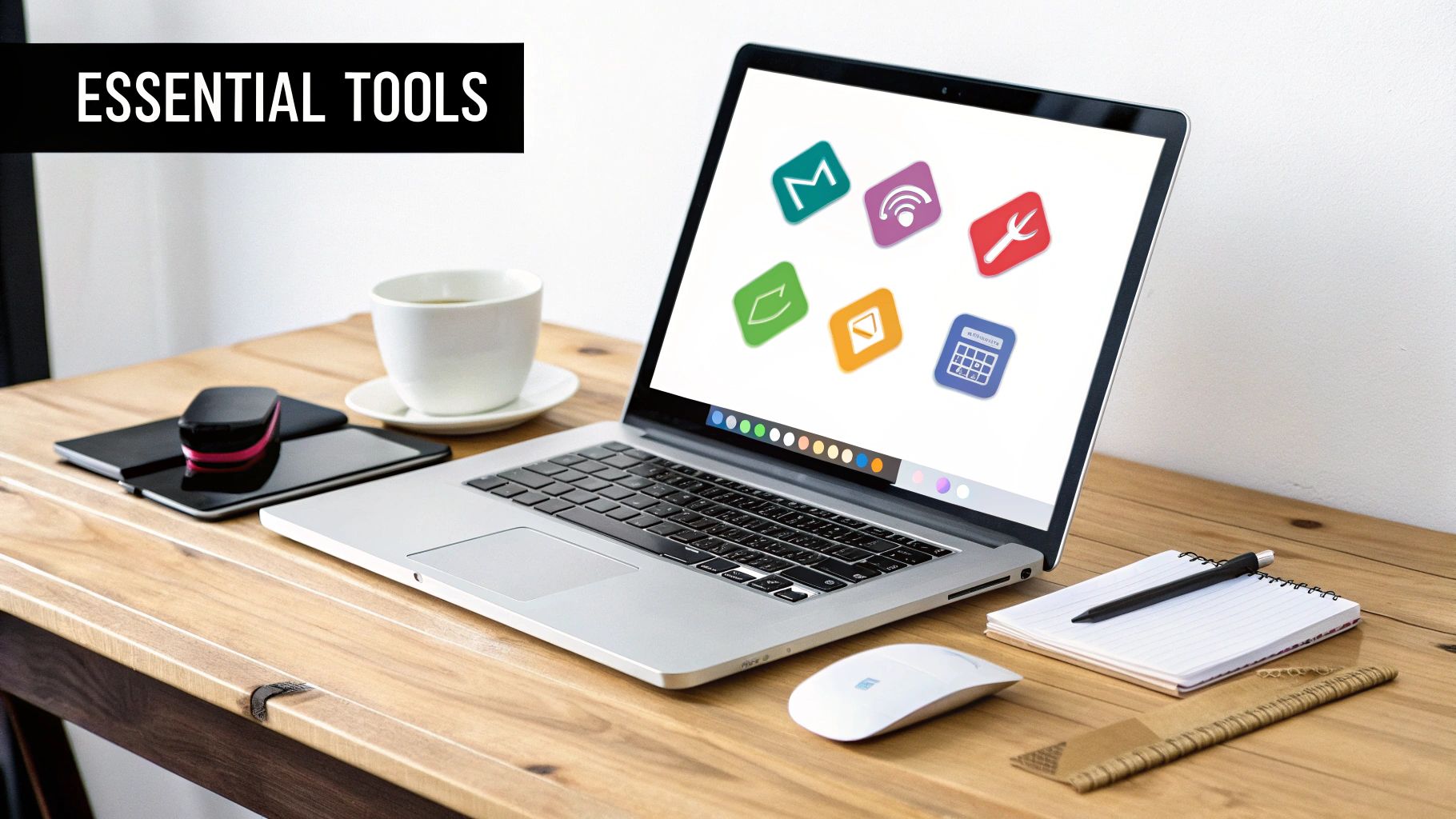
The next major leap in 3D product rendering isn't on the horizon—it's already here, and it’s powered by Artificial Intelligence. But AI isn't replacing creative professionals. Think of it as a powerful co-pilot, handling the tedious, repetitive tasks that used to consume hours and slow down entire projects.
This frees up designers and artists to focus on what they do best: strategy, storytelling, and refining the artistic direction. AI isn’t just about making the existing process faster; it’s unlocking entirely new ways of working. From generating textures with a simple text command to automatically staging entire scenes, AI is making high-end 3D product rendering more efficient and accessible than ever before.
Accelerating the Creative Workflow
The most immediate benefit of AI is speed. It dramatically reduces the time spent on the more laborious parts of the rendering pipeline.
Instead of an artist spending hours manually creating a brushed metal or worn leather texture, an AI algorithm can generate a photorealistic material from a simple description. That is countless hours given back to the team for actual creative exploration.
Additionally, AI can automate complex tasks like lighting setups and scene composition. Imagine an algorithm that analyzes your 3D model and instantly suggests the best camera angles and lighting to highlight its key features. These tools are like having an intelligent assistant on hand, allowing your team to generate more variations and iterate on ideas at a rapid pace.
AI is leveling the playing field. It's giving smaller businesses access to sophisticated visual tools that were once only available to companies with massive budgets.
From Text Prompts to Tangible Models
This is where the technology gets particularly interesting. Generative AI can now create detailed 3D assets directly from a text prompt or even a single 2D image. This completely changes the early stages of 3D product rendering, turning a simple idea into a workable model in seconds.
Want a deeper dive into how this works? We’ve covered it in our article on AI 3D model generation.
This provides a major boost for rapid prototyping. A designer can generate a dozen concepts for a new product, evaluate them in 3D, and select the best one before committing to detailed modeling work.
- AI-Driven Material Generation: Creates lifelike surfaces from text, saving huge amounts of manual effort.
- Automated Scene Arrangement: Intelligently places objects, sets up lights, and finds optimal camera angles.
- Text-to-3D Creation: Turns simple text prompts into initial 3D models to jump-start the concept phase.
The Growing Impact of AI in Creative Industries
AI's role in 3D product rendering is no longer a niche trend—it’s a core driver of the industry's future. The broader 3D rendering market is already growing at a healthy 18% CAGR, but the AI-powered niche is expanding even faster.
The market for AI image and 3D model generation is projected to hit $1.37 billion by 2032, expanding at a 22.01% CAGR. This isn't just a creative phenomenon; it's a major business shift. For more context, check out these 5 ways AI is transforming business across different sectors. This incredible growth demonstrates that AI is becoming an essential tool for any enterprise-level creative team looking to remain competitive.
Bringing 3D Rendering into Your Business
Moving from theory to practice is where you’ll find your competitive edge. Bringing 3D product rendering into your business doesn’t have to be a massive, overnight switch. It's a strategic move that can start small and scale up quickly. The real goal is to treat this technology as a core part of your visual marketing engine, not just a one-off project.
A great first step is to run a pilot project with a single product line. Pick something that has many color options or is difficult to photograph well. This focused approach lets you learn the process, set a quality benchmark, and see tangible results without overhauling your entire marketing operation.
Choosing the Right Path Forward
When you're ready to proceed, you have a key decision to make: build your own in-house team, hire a specialized agency, or purchase the software and manage it yourself. For most companies, working with an expert agency or a skilled freelancer is the quickest way to get excellent results without the steep learning curve and overhead of an internal department.
When you're vetting a partner or evaluating software, here's what to consider:
- Portfolio Quality: Do their final images have the photorealistic quality your brand requires?
- Technical Capabilities: Can they handle complex materials, lighting, and models similar to your products?
- Workflow Integration: How will they coordinate with your design and marketing teams? Will it be a smooth process or a constant challenge?
- Scalability: Can they grow with you? It's one thing to handle a single product line, but can they support your entire catalog in the future?
For those thinking about going the software route, there are many excellent tools available. To get a feel for what’s on the market, check out our guide on free software for rendering.
Building a Scalable Asset Library
The true power of 3D product rendering is realized when you start thinking long-term. Every 3D model you create is a reusable digital asset. By building an organized library of these models, you're creating a valuable resource for all your future visual content—from website images and social media posts to animations and AR experiences.
Treating your 3D models as a permanent, valuable asset library is the key to maximizing your return on investment. This approach ensures long-term efficiency and brand consistency.
Adopting 3D rendering also introduces new files and workflows, so you need a system to manage it all. You can find excellent advice on digital asset management best practices to keep everything organized and secure from day one. When you align your rendering process with your product development cycle, you’re not just creating attractive pictures—you're building a smarter, more efficient content machine.
A Few Common Questions About 3D Product Rendering
Exploring the world of 3D product rendering usually brings up a few questions. Getting clear answers is the first step to determining if it’s the right move for your business. Let's review some of the most common inquiries from those new to the process.
What’s the Difference Between 3D Modeling and 3D Rendering?
It’s easy to confuse these two, but they are distinct parts of the same process. Think of it like building a movie set versus actually filming the scene.
3D modeling is the construction phase. It’s where an artist digitally sculpts your product’s shape and structure using specialized software. The result is a digital blueprint, like a wireframe skeleton of the object.
3D product rendering, on the other hand, is the photoshoot. It’s the art of turning that digital model into a high-quality, photorealistic image. This is where materials, textures, lighting, and camera angles all come into play. You can't have one without the other; rendering needs a model to work with, and a model is just a blueprint until it’s brought to life through rendering.
How Long Does a Rendering Project Actually Take?
The answer is, "it depends," and for good reason. A simple shot of a single product against a white background might only take a few hours. But a complex lifestyle scene with multiple products and a custom environment could take several days or even a couple of weeks.
A few factors will affect the timeline:
- Model Complexity: A simple bottle is a quick job. A piece of industrial machinery with many intricate parts is more involved.
- Scene Complexity: A clean studio setup is fast. A custom-designed kitchen or an outdoor landscape adds more time.
- Asset Readiness: If you already have a high-quality CAD or 3D file, you're ahead. If a model needs to be built from scratch using only photos, it will take longer.
- Rounds of Feedback: The review process is a significant factor. Clear, consolidated feedback keeps the project moving smoothly.
As a general rule, a standard project—from modeling to final image—can take anywhere from a few days to two weeks. The best way to manage this is to have a direct conversation with your creative partner upfront to set clear expectations.
What’s the Average Cost for Rendering Services?
Just like timelines, there’s no flat rate. Pricing for 3D product rendering is tied directly to the scope and complexity of the work. A single, simple render might cost a few hundred dollars, while a detailed animation or an interactive 3D configurator could be in the thousands.
The main cost drivers are the time and skill needed for modeling, texturing, and setting up the scene. However, remember that you’re not just purchasing a one-off image. You're investing in a flexible digital asset you can reuse and repurpose for countless marketing campaigns in the future, which delivers incredible long-term value.
Ready to accelerate your creative workflow and get stunning 3D visuals more efficiently? See how Virtuall uses AI to turn your ideas into high-quality 3D models in seconds. Visit us at https://virtuall.pro to learn more.

